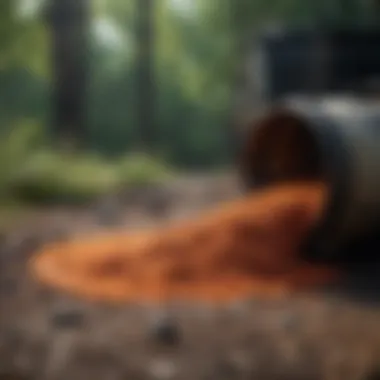Proper Paint Disposal Methods: A Complete Guide for Eco-Friendly Practices


In the realm of household items, paint stands out as an essential yet potentially hazardous material that necessitates careful handling and disposal procedures. The chemical composition of paint renders it incompatible with conventional waste management methods, requiring a specialized approach to avoid detrimental effects on the environment. Through a detailed exploration of the various types of paint and the ecological repercussions of improper disposal, individuals can enhance their awareness of the significance of responsible paint disposal practices.
Current Status and Challenges
Paint disposal poses a pertinent environmental challenge due to its detrimental impact on soil and water quality if handled incorrectly. With the prevalent practice of improper disposal in landfills or water bodies, the ecosystem faces significant risks from the toxic substances present in many paint formulations. Addressing this issue demands a critical examination of the current disposal methods and the environmental threats they pose, prompting the urgent need for sustainable solutions.
Sustainable Solutions
To mitigate the environmental concerns associated with paint disposal, it is imperative to explore sustainable practices that minimize harm and promote resource conservation. Adopting eco-friendly disposal options such as recycling unused paint, utilizing paint hardeners, or participating in community paint collection programs can significantly reduce the ecological footprint of paint disposal. By showcasing successful case studies of effective resource management, individuals can draw inspiration from tangible examples of sustainable paint disposal efforts.
Impact and Importance
The improper disposal of paint holds far-reaching consequences for ecosystems, communities, and future generations, emphasizing the interconnectedness of environmental stewardship and sustainable resource use. Analyzing the impact of negligent paint disposal on soil fertility, water purity, and overall ecosystem health underscores the pivotal role of conservation efforts in safeguarding natural resources. Recognizing the critical importance of responsible paint disposal not only preserves environmental integrity but also supports long-term sustainability initiatives.
Prolusion
Paint disposal is a critical aspect that often goes overlooked in household waste management. Understanding how to properly discard paint is essential due to its chemical composition, which can have harmful effects on the environment if not handled correctly. This comprehensive guide aims to provide readers with valuable insights into the various methods available for responsibly disposing of different types of paint. By delving into this topic, individuals can contribute positively to environmental conservation efforts and ensure that their paint waste does not pose a threat to ecosystems.
Why Paint Disposal Matters
Proper paint disposal holds significant importance for several reasons. First and foremost, paint contains a myriad of chemicals, such as volatile organic compounds (VOCs) and heavy metals, that can leach into the soil and water sources if not disposed of correctly. These substances have the potential to contaminate water supplies and harm aquatic life, disrupting delicate ecosystems. Furthermore, improper paint disposal can lead to air pollution, as certain paint components can release toxic fumes when incinerated or left to degrade haphazardly.


Environmental Impact of Improper Disposal
The consequences of improper paint disposal are far-reaching and can have devastating effects on the environment. When paint is poured down drains or dumped into landfills, it can seep into the groundwater, contaminating it with harmful chemicals. This not only poses a risk to human health but also endangers wildlife and plant species that rely on unpolluted natural habitats. Additionally, the buildup of paint waste in landfills contributes to environmental degradation and increases the demand for new raw materials, perpetuating a harmful cycle of resource depletion. By understanding the environmental impact of improper paint disposal, individuals can make informed decisions to mitigate these risks and protect our planet.
Types of Paint
Paint comes in various formulations, each with its unique characteristics and considerations. Understanding the different types of paint is essential for effective disposal methods. Oil-based paint, known for its durability and smooth finish, contains harmful solvents requiring special handling. Latex paint, water-based and easy to clean, poses fewer environmental risks but still needs proper disposal. Acrylic paint, with its quick drying nature and versatility, also necessitates specific disposal procedures to minimize ecological impact. Other specialty paints like spray paint or varnishes may have additional hazardous components demanding careful disposal.
Oil-Based Paint
Oil-based paint is popular for its robust adhesion and high sheen, ideal for surfaces requiring extensive durability. However, its composition includes solvents like mineral spirits or toluene, posing health hazards and environmental risks if not disposed of correctly. Proper disposal of oil-based paint involves using local hazardous waste collection programs or dedicated paint recycling facilities to prevent soil and water contamination.
Latex Paint
As a water-based paint, latex paint is easier to clean up and emits fewer volatile organic compounds than oil-based alternatives. Despite its lower toxicity, latex paint still requires responsible disposal to avoid environmental harm. Drying out latex paint before disposal is a common method, allowing it to solidify before discarding in regular household trash. However, large quantities should be taken to specialized paint recycling centers for safe disposal.
Acrylic Paint
Acrylic paint, a favorite among artists and DIY enthusiasts, offers fast drying times and vibrant pigments. While water-based, acrylic paint should not be poured down drains as it can still pollute water sources. Unused acrylic paint can be air-dried or solidified before disposal to minimize ecological impact. Reusing or donating leftover acrylic paint is another eco-friendly option to reduce waste.
Other Specialty Paints
Specialty paints like aerosols, gloss finishes, or enamel paints may contain additional hazardous substances requiring specific disposal methods. Paint exchange programs or local collection events are excellent avenues for safely discarding these paints. Moreover, checking with local authorities for disposal guidelines ensures compliance with regulations and protects the environment from harmful pollutants.


Disposal Methods
In the realm of proper paint disposal, the significance of methods cannot be overstated. Opting for the correct disposal technique ensures that harmful substances within the paint do not negatively impact the environment. By meticulously following appropriate means of disposal, individuals play a pivotal role in preserving ecological equilibrium. Whether engaging with local household hazardous waste collection programs, participating in paint exchange initiatives, or employing paint recycling centers, each method carries distinct advantages and considerations. These methods not only aid in reducing environmental pollution but also contribute to sustainable waste management practices.
Local Household Hazardous Waste Collection Programs
Local household hazardous waste collection programs stand as beacons of responsible waste disposal. These initiatives offer community members a safe and regulated channel to discard hazardous materials like paint. By utilizing these programs, individuals prevent harmful substances from seeping into water bodies or contaminating the soil. The convenience of these programs encourages widespread participation, fostering a culture of environmental responsibility within localities. Additionally, these programs often provide educational resources on the repercussions of improper waste disposal, thereby raising awareness among residents.
Paint Exchange Programs
Paint exchange programs emerge as innovative solutions in the realm of sustainable waste management. These programs facilitate the exchange of surplus or unused paint among individuals, promoting resource conservation. Participants can contribute to the reduction of paint wastage by availing of paints from these exchanges, thereby decreasing the demand for new paint production. Such initiatives not only foster community engagement but also uphold the principles of circular economy by extending the lifespan of products. By partaking in paint exchange programs, individuals actively contribute to minimizing waste generation and promoting a greener environment.
Drying Out Paint
The process of drying out paint serves as a practical method for its safe disposal. By allowing paint to solidify completely, individuals can render it non-hazardous and ready for conventional disposal. Simple techniques such as mixing paint with absorbent materials like cat litter or sawdust expedite the drying process. Once solidified, the paint can be disposed of with regular household waste, minimizing the risk of environmental contamination. Drying out paint not only simplifies its disposal but also mitigates the potential hazards posed by liquid paint, ensuring a safer and more sustainable waste management approach.
Paint Recycling Centers
Paint recycling centers play a pivotal role in diverting paint from landfills and promoting recycling practices. These specialized facilities accept unwanted paint products, facilitating their proper treatment and recycling. Through innovative processes, such as paint reprocessing and remanufacturing, these centers transform discarded paint into reusable materials, reducing the strain on natural resources. By engaging with paint recycling centers, individuals contribute to the circular economy model, where materials are perpetually reused and recycled, minimizing environmental impact. The existence of these centers not only enhances resource efficiency but also underscores the importance of responsible paint disposal within the broader context of sustainability initiatives.
Tips for Safe Paint Disposal
The section on 'Tips for Safe Paint Disposal' plays a pivotal role in this comprehensive guide on the proper disposal of paint. It serves as a key component in ensuring that individuals understand and implement best practices when getting rid of paint. One of the primary aspects to focus on here is the necessity of following safety guidelines to prevent harm to both one's health and the environment. By incorporating these tips, individuals can contribute to reducing the ecological footprint of paint disposal.


To begin with, 'Seal Cans Properly' is a fundamental aspect of safe paint disposal. Properly sealed cans help prevent spills and leaks, which can contaminate soil and water sources. When cans are not sealed correctly, the paint inside can dry out, making it challenging to reuse or recycle. Additionally, sealed cans reduce the risk of exposure to harmful fumes, especially for oil-based paints that contain volatile organic compounds (VOCs). By following this practice, individuals can contain paint securely until it is ready for disposal.
On the topic of 'Avoid Pouring Down Drains,' it is essential to highlight the detrimental impact this action can have on the environment. Paint contains chemicals that can pollute water bodies and harm aquatic life. When poured down drains, these toxins can find their way into rivers and oceans, posing a significant threat to ecosystems. Therefore, it is crucial to educate individuals on the proper disposal methods to prevent such pollution and protect water quality.
Lastly, 'Consult Local Regulations' emphasizes the importance of understanding and adhering to regional guidelines for paint disposal. Local regulations often dictate specific protocols for handling hazardous waste, including paint. By consulting these regulations, individuals can ensure compliance with local laws and contribute to a safer and cleaner environment for all. Moreover, staying informed about disposal regulations encourages responsible decision-making and fosters a culture of environmental awareness within communities.
Environmental Benefits of Proper Paint Disposal
Proper disposal of paint is not only a matter of cleanliness but also crucial for environmental protection. When it comes to the environmental benefits of proper paint disposal, several key aspects come into play.
Preventing Water Contamination (at least 250-300 words)
One of the primary concerns related to paint disposal is the potential for water contamination. Improperly disposed of paint can seep into the soil and find its way into water sources, polluting rivers, lakes, and even groundwater reservoirs. This contamination poses a serious threat to aquatic ecosystems, affecting not only the flora and fauna but also human health. By ensuring that unused paint is disposed of correctly through designated channels such as recycling centers or hazardous waste collection programs, we can significantly reduce the risk of water contamination.
Reducing Landfill Waste (at least 250-300 words)
With the vast quantities of waste generated daily, landfills are under immense pressure. Paint cans, if not properly disposed of, contribute to this growing issue. The chemicals present in paint can leach into the soil over time, leading to soil degradation and potential contamination of underground water sources. By promoting proper paint disposal methods such as recycling or drying out paint for solid waste disposal, we can reduce the amount of paint waste ending up in landfills. This, in turn, helps alleviate the strain on landfill capacities and minimizes the environmental impact of paint disposal.
Promoting Sustainable Practices (at least 250-300 words)
An essential aspect of proper paint disposal is the promotion of sustainable practices. By choosing to dispose of paint responsibly, individuals contribute to the larger goal of sustainable waste management. Embracing eco-friendly disposal options not only reduces the environmental footprint of paint disposal but also sets a positive example for others to follow. Sustainable practices like participating in paint exchange programs, supporting local recycling initiatives, and abiding by regulations for hazardous waste disposal help create a culture of environmental stewardship. By advocating for sustainable paint disposal practices, we pave the way for a greener, cleaner future for generations to come.
Epilogue
Properly disposing of paint is not just a mundane task but a crucial step in preserving our environment and safeguarding our health. In this comprehensive guide, we have highlighted the significance of responsible paint disposal, emphasizing the impacts of improper practices on ecosystems and human well-being. By meticulously examining the various types of paint and the suitable disposal methods for each, readers have acquired invaluable knowledge for making informed decisions when handling paint waste.
The essence of this conclusion lies in understanding that the consequences of disregarding proper paint disposal go beyond mere inconvenience; they extend to polluting water sources, contaminating soil, and jeopardizing biodiversity. Moreover, embracing eco-friendly paint disposal alternatives is not merely a choice but a moral obligation towards fostering sustainable living practices. As we navigate through the complexities of waste management, it becomes evident that small actions at the individual level can collectively lead to significant environmental benefits.
Therefore, the crux of this article underscores a call to action for all stakeholders to prioritize responsible paint disposal methods. By adopting the recommended tips and guidelines, such as sealing paint cans securely, abstaining from pouring paint down drains, and adhering to local regulations, individuals can contribute meaningfully to reducing water contamination and minimizing landfill waste. Ultimately, the overarching goal of this guide is to empower readers with the knowledge and tools necessary to become conscientious stewards of the environment, fostering a holistic approach towards sustainable paint disposal practices.



